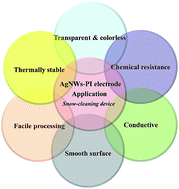Highly transparent silver nanowire–polyimide electrode as a snow-cleaning device†
Abstract
In this study, highly transparent and flexible electrodes were prepared by the hybrid technique of silver nanowires (AgNWs) and colorless high performance polyimides (PIs). By introducing AgNWs with a high aspect ratio of 600, the novel flexible AgNW–PI electrodes having figure of merit (FoM) value up to 260 could be obtained with a resistance of 3.6 Ω sq−1 and transmittance up to 70% at a 550 nm wavelength. Moreover, the PI binder effectively enhanced the adhesion between AgNWs and the PI substrate even after bending for 12 000 cycles and tape peeling for 1000 cycles, respectively. The obtained highly transparent and flexible AgNW electrodes could endure harsh working environments and post-processing by taking the thermal and chemical stability advantages of PIs. Furthermore, highly transparent AgNW–PI hybrid electrodes could be fabricated to demonstrate their feasibility as a snow-cleaning heater.


 Please wait while we load your content...
Please wait while we load your content...